Gandhi (film)
9.2 /10 1 Votes9.2
5/5 The Telegraph 4/4 Roger Ebert Genre Biography, Drama, History Language English | 8.1/10 IMDb 88% Rotten Tomatoes Release date November 30, 1982 (India) Duration Country United KingdomIndiaUnited States | |||||||||||||||||||||||||||||||||
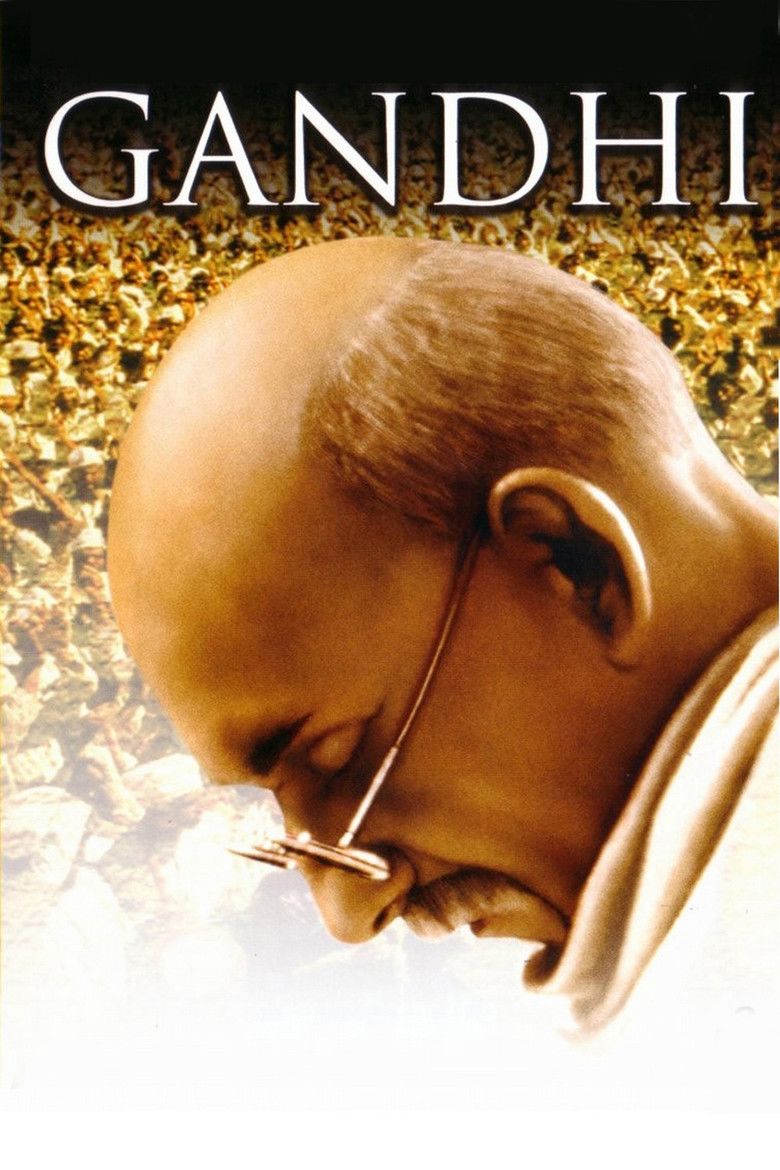 | ||||||||||||||||||||||||||||||||||
Release date 30 November 1982 (1982-11-30) (New Delhi)3 December 1982 (1982-12-03) (United Kingdom)8 December 1982 (1982-12-08) (United States) Songs 31st of January 1948 Cast (Mahatma Gandhi), (Kasturba Gandhi), (Margaret Bourke-White), (Pandit Nehru), (Nahari), (Sardar Vallabhbhai Patel) Similar movies The Great Escape , Catch a Fire , Mandela: Long Walk to Freedom , The Bang Bang Club , Cry Freedom , Leatherlip Tagline His Triumph Changed The World Forever. | ||||||||||||||||||||||||||||||||||
Gandhi is a 1982 British-Indian epic biographical drama film which dramatises the life of Mohandas Karamchand Gandhi, the leader of India's non-violent, non-cooperative independence movement against the United Kingdom's rule of the country during the 20th century. Gandhi was written by John Briley and produced and directed by Richard Attenborough. It stars Ben Kingsley in the title role.
Contents
- Plot
- Production
- Casting
- Release and reception
- Box office performance
- Critical response
- Rupinder gandhi full movie dev kharoud full punjabi movie new punjabi movies 2017
- References

The film covers Gandhi's life from a defining moment in 1893, as he is thrown off a South African train for being in a whites-only compartment, and concludes with his assassination and funeral in 1948. Although a practising Hindu, Gandhi's embracing of other faiths, particularly Christianity and Islam, is also depicted.

Gandhi was released in India on 30 November 1982, in the United Kingdom on 3 December, and in the United States on 10 December. It was nominated for Academy Awards in eleven categories, winning eight, including Best Picture and Best Director for Attenborough, Best Actor for Ben Kingsley, and Best Screenplay Written Directly for the Screen for Briley. The film was screened retrospectively on 12 August 2016 as the Opening Film at the Independence Day Film Festival jointly presented by the Indian Directorate of Film Festivals and Ministry of Defence, commemorating 70th Indian Independence Day. The screenplay of Gandhi is available as a published book.
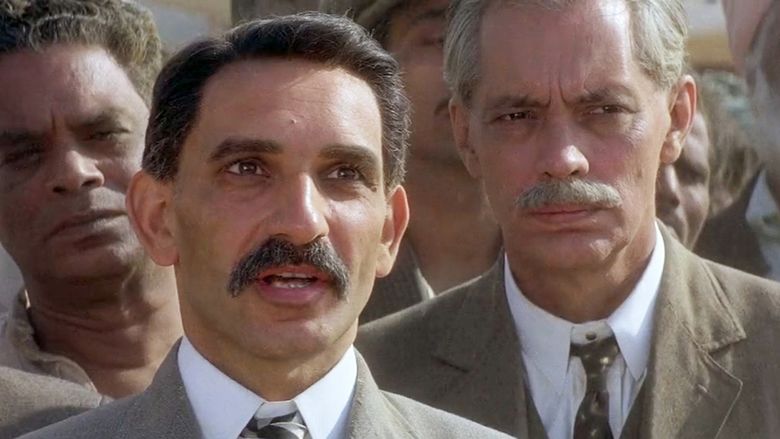
Plot
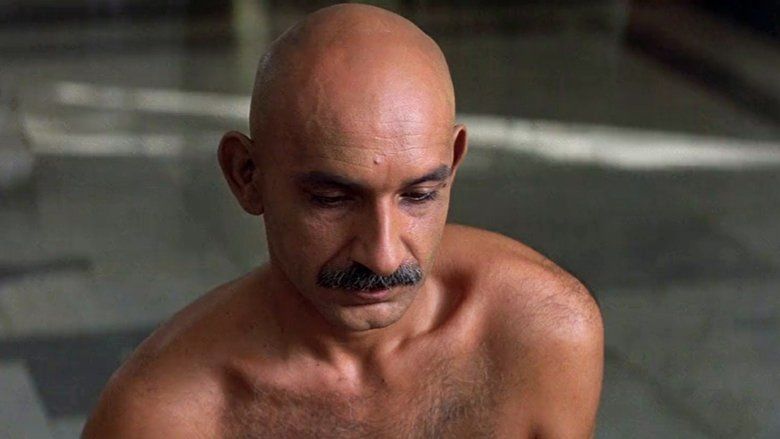
The film opens with a statement from the filmmakers explaining their approach to the problem of filming Gandhi's complex life story:

No man's life can be encompassed in one telling. There is no way to give each year its allotted weight, to include each event, each person who helped to shape a lifetime. What can be done is to be faithful in spirit to the record and to try to find one's way to the heart of the man...
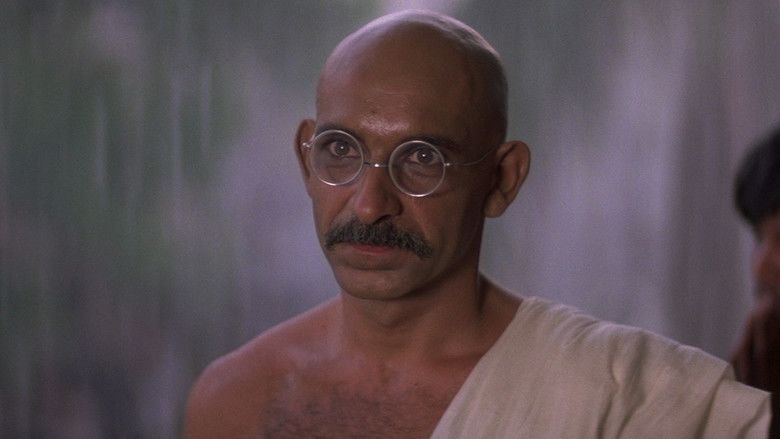
The film begins on the day of Gandhi's assassination on 30 January 1948. After an evening prayer, an elderly Gandhi is helped out for his evening walk to meet a large number of greeters and admirers. One of these visitors, Nathuram Godse, shoots him point blank in the chest. Gandhi exclaims, "Oh, God!", and then falls dead. The film then cuts to a huge procession at his funeral, which is attended by dignitaries from around the world.
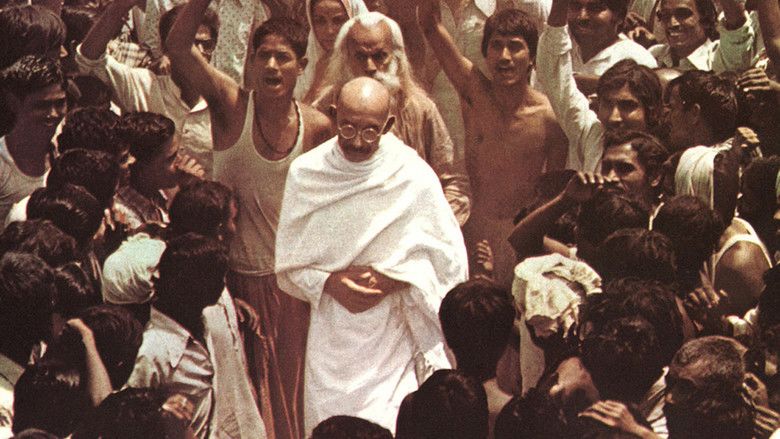
The early life of Gandhi is not depicted in the film. Instead, the story flashes back 55 years to a life-changing event: in 1893, the 23-year-old Gandhi is thrown off a South African train for being an Indian sitting in a first-class compartment despite having a first-class ticket. Realizing the laws are biased against Indians, he then decides to start a nonviolent protest campaign for the rights of all Indians in South Africa. After numerous arrests and unwelcome international attention, the government finally relents by recognizing some rights for Indians.

In 1915, as a result of his victory in South Africa, Gandhi is invited back to India, where he is now considered something of a national hero. He is urged to take up the fight for India's independence, (Swaraj, Quit India) from the British Empire. Gandhi agrees, and mounts a nonviolent non-cooperation campaign of unprecedented scale, coordinating millions of Indians nationwide. There are some setbacks, such as violence against the protesters and Gandhi's occasional imprisonment. The 1919 Jallianwala Bagh massacre is also depicted in the film.
Nevertheless, the campaign generates great attention, and Britain faces intense public pressure. In 1930, Gandhi protests against the British-imposed salt tax via the highly symbolic Salt March. He also travels to London for a conference concerning Britain's possible departure from India; this, however, proves fruitless. After the Second World War, Britain finally grants Indian independence. Indians celebrate this victory, but their troubles are far from over. The country is subsequently divided by religion. It is decided that the northwest area and the eastern part of India (current-day Bangladesh), both places where Muslims are in the majority, will become a new country called Pakistan. It is hoped that by encouraging the Muslims to live in a separate country, violence will abate. Gandhi is opposed to the idea, and is even willing to allow Muhammad Ali Jinnah to become the first prime minister of India, but the Partition of India is carried out nevertheless. Religious tensions between Hindus and Muslims erupt into nationwide violence. Horrified, Gandhi declares a hunger strike, saying he will not eat until the fighting stops. The fighting does stop eventually.
Gandhi spends his last days trying to bring about peace between both nations. He thereby angers many dissidents on both sides, one of whom (Godse) is involved in a conspiracy to assassinate him.
As Godse shoots Gandhi in a scene recalling the opening, the film cuts to black and Gandhi is heard in a voiceover, saying "Oh, God!" The audience then sees Gandhi's cremation; the film ending with a scene of Gandhi's ashes being scattered on the holy Ganga. As this happens, viewers hear Gandhi in another voiceover from earlier in the film:
As the list of actors is seen at the end, the hymns "Vaishnava Jana To" and "Raghupati Raghava Raja Ram" are heard.
Production
This film had been Richard Attenborough's dream project, although two previous attempts at filming had failed. In 1952, Gabriel Pascal secured an agreement with the Prime Minister of India (Pandit Nehru) to produce a film of Gandhi's life. However, Pascal died in 1954 before preparations were completed.
In 1962 Attenborough was contacted by Motilal Kothari, an Indian-born civil servant working with the Indian High Commission in London and a devout follower of Gandhi. Kothari insisted that Attenborough meet him to discuss a film about Gandhi. Attenborough agreed, after reading Louis Fischer's biography of Gandhi and spent the next 18 years attempting to get the film made. He was able to meet prime minister Jawaharlal Nehru and his daughter Indira Gandhi through a connection with Lord Louis Mountbatten, the last Viceroy of India. Nehru approved of the film and promised to help support its production, but his death in 1964 was one of the film's many setbacks. Attenborough would dedicate the film to the memory of Kothari, Mountbatten, and Nehru.
David Lean and Sam Spiegel had planned to make a film about Gandhi after completing The Bridge on the River Kwai, reportedly with Alec Guinness as Gandhi. Ultimately, the project was abandoned in favour of Lawrence of Arabia (1962). Attenborough reluctantly approached Lean with his own Gandhi project in the late 1960s, and Lean agreed to direct the film and offered Attenborough the lead role. Instead Lean began filming Ryan's Daughter, during which time Motilai Kothari had died and the project fell apart.
Attenborough again attempted to resurrect the project in 1976 with backing from Warner Brothers. Then prime minister Indira Gandhi declared a state of emergency in India and shooting would be impossible. Co-producer Rani Dube persuaded prime minister Indira Gandhi to provide the first $10 million from the National Film Development Corporation of India, chaired by D. V. S. Raju at that time, on the back of which the remainder of the funding was finally raised.Finally in 1980 Attenborough was able to secure the remainder of the funding needed to make the film. Screenwriter John Briley had introduced him to Jake Eberts, the chief executive at the new Goldcrest production company that raised approximately two-thirds of the film's budget.
Shooting began on 26 November 1980 and ended on 10 May 1981. Over 300,000 extras were used in the funeral scene, the most for any film according to Guinness World Records.
Casting
During pre-production, there was much speculation as to who would play the role of Gandhi. The choice was Ben Kingsley, who is partly of Indian heritage (his father was Gujarati and his birth name is Krishna Bhanji).
Release and reception
Gandhi premiered in New Delhi, India on 30 November 1982. Two days later, on 2 December, it had a Royal Premiere at the Odeon Leicester Square in London in the presence of Prince Charles and Princess Diana. The film had a limited release in the US on 8 December 1982, followed by a wider release in January 1983.
Box office performance
Gandhi grossed a total of $52.7 million in North America and became the 12th-highest-grossing film of 1982 there. Audiences around the world loved the film and went on to see it several times helping the film to generate more income. In India in particular, it was one of the highest-grossing film of all-time (and the highest for a foreign film) during the time of its release by earning over ₹100 crore or 1 billion rupees. At today's exchange rate, that amount to $14.9 million, still making it one of the highest-grossing Hollywood/imported film in the country. It was shown tax free in Bombay (known as Mumbai since 1995) and Delhi.
Critical response
Reviews were broadly positive not only domestically (in India) but also internationally. The film was discussed or reviewed in Newsweek, Time, the Washington Post, The Public Historian, Cross Currents, The Journal of Asian Studies, Film Quarterly, The Progressive, The Christian Century and elsewhere. Ben Kingsley's performance was especially praised. Among the few who took a more negative view of the film, historian Lawrence James called it "pure hagiography" while anthropologist Akhil Gupta said it "suffers from tepid direction and a superficial and misleading interpretation of history." The film was also criticised by some right-wing commentators who objected to the film's advocacy of nonviolence, including Pat Buchanan, Emmett Tyrrell, and especially Richard Grenier.
In Time, Richard Schickel wrote that in portraying Gandhi's "spiritual presence... Kingsley is nothing short of astonishing." A "singular virtue" of the film is that "its title figure is also a character in the usual dramatic sense of the term." Schickel viewed Attenborough's directorial style as having "a conventional handsomeness that is more predictable than enlivening," but this "stylistic self-denial serves to keep one's attention fastened where it belongs: on a persuasive, if perhaps debatable vision of Gandhi's spirit, and on the remarkable actor who has caught its light in all its seasons." Roger Ebert gave the film four-stars and called it a "remarkable experience", and placed it 5th on his 10 best films of 1983.
In Newsweek, Jack Kroll stated that "There are very few movies that absolutely must be seen. Sir Richard Attenborough's Gandhi is one of them." The movie "deals with a subject of great importance... with a mixture of high intelligence and immediate emotional impact... [and] Ben Kingsley... gives what is possibly the most astonishing biographical performance in screen history." Kroll stated that the screenplay's "least persuasive characters are Gandhi's Western allies and acolytes" such as an English cleric and an American journalist, but that "Attenborough's 'old-fashioned' style is exactly right for the no-tricks, no-phony-psychologizing quality he wants." Furthermore, Attenborough
mounts a powerful challenge to his audience by presenting Gandhi as the most profound and effective of revolutionaries, creating out of a fierce personal discipline a chain reaction that led to tremendous historical consequences. At a time of deep political unrest, economic dislocation and nuclear anxiety, seeing "Gandhi" is an experience that will change many minds and hearts.
According to the Museum of Broadcast Communications there was "a cycle of film and television productions which emerged during the first half of the 1980s, which seemed to indicate Britain's growing preoccupation with India, Empire and a particular aspect of British cultural history". In addition to Gandhi, this cycle also included Heat and Dust (1983), Octopussy (1983), The Jewel in the Crown (1984), The Far Pavilions (1984) and A Passage to India (1984).
The film holds an 87% rating on website Rotten Tomatoes based on 52 reviews collected with an average score of 8/10. Its critics' consensus reads: "Director Richard Attenborough is typically sympathetic and sure-handed, but it's Ben Kingsley's magnetic performance that acts as the linchpin for this sprawling, lengthy biopic." CinemaScore reported that audiences gave the film a rare "A+" grade. In 2010, the Independent Film & Television Alliance selected the film as one of the 30 Most Significant Independent Films of the last 30 years
Other negative reviews were from Patrick French who wrote the following in his book India: A Portrait
"An important origin of one myth about Gandhi was Richard Attenborough’s 1982 film. Take the episode when the newly arrived Gandhi is ejected from a first-class railway carriage at Pietermaritzburg after a white passenger objects to sharing space with a “coolie” (an Indian indentured labourer). In fact, Gandhi’s demand to be allowed to travel first-class was accepted by the railway company. Rather than marking the start of a campaign against racial oppression, as legend has it, this episode was the start of a campaign to extend racial segregation in South Africa. Gandhi was adamant that “respectable Indians” should not be obliged to use the same facilities as “raw Kaffirs”. He petitioned the authorities in the port city of Durban, where he practised law, to end the indignity of making Indians use the same entrance to the post office as blacks, and counted it a victory when three doors were introduced: one for Europeans, one for Asiatics and one for Natives."
Richard Grenier in his 1983 article, The Gandhi Nobody Knows, which was also the title of the book of the same name and topic, also criticized the film, arguing it misportrayed him as a "saint". He also alleged the Indian government admitted to financing about a third of the film's budget.
Grenier's book later became an inspiration for G.B. Singh's book Gandhi: Behind the Mask of Divinity. Parts of the book also discuss the film negatively. G.B. Singh, a long term critic of Gandhi, also went on to co-author Gandhi Under Cross Examination with Timothy Watson (also known as Timothy Spearman).
In the DVD edition of the 1998 film Jinnah, the director's commentary of the film makes mention of the 1982 film. In the commentary, both Sir Christopher Lee, who portrayed the older Muhammed Ali Jinnah, and director Jamil Dehlavi criticized the film Gandhi for it's portrayal of Jinnah, arguing it to be demonizing and historically inaccurate.
Rupinder gandhi full movie dev kharoud full punjabi movie new punjabi movies 2017
References
Gandhi (film) WikipediaGandhi (film) IMDbGandhi (film) The TelegraphGandhi (film) Rotten TomatoesGandhi (film) Roger EbertGandhi (film) themoviedb.org
